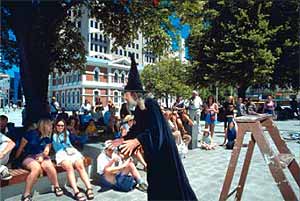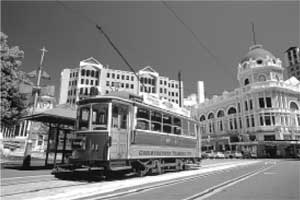| Our Environment: Issue 25 Summer 2000 |
 The Square needs activities that become
a routine part of life for Christchurch people, according to a leading urban designer.
The Square needs activities that become
a routine part of life for Christchurch people, according to a leading urban designer.
Whether those activities involve people sitting at cafe tables with friends, buying stamps or selecting fresh produce every Saturday morning, the Square must become a part of their everyday lives, says Nicole Lauenstein, Architectural Design Faculty Director of the Design and Arts College of New Zealand. At present many locals use it simply as a thoroughfare because there is little to involve and interest them enough to stay.
Ms Lauenstein, who has a masters degree in architecture and an urban design degree, has worked on highprofile projects including the velodrome for the Sydney Olympics. Based in a building “behind” the Square, she has watched the new design take shape and the resulting controversy over its paving and scale. Asked to comment on the new Square, she says the City’s prime urban open space has a lot going for it. The height of surrounding buildings is in proportion to the scale of the Square while the open design is visually appealing and relates well to the remaining heritage buildings. A hard surface is necessary to fulfil its civic functions as an urban centre and provide access to all points of the City. The trees and the link between the Cathedral and Worcester Boulevard are both very positive features. However, to get the Square to “work”, she believes it is important not to get too hung up on design issues.
“The Square is a stage for people to act on,” says Ms Lauenstein. “Those responsible have to provide the props.” It must become more and more a local Christchurch space with activity around the clock. She says the corner of the Square by the Old Post Office works well with people happy to sit in the sun and observe. At lunchtime the Wizard is very much a Christchurch institution and Friday concerts generate activity and colour. If the police kiosk stays, it should be revamped and opened up for a new use to counterbalance activity in the old Post Office corner. It would make a great café, Ms Lauenstein says.
 More people living in vacant space in buildings around the Square would inject
new life. A sculpture or other feature that appeals to children is also necessary to cater
for their needs. However, she says too many ground floor spaces like those in the BNZ and
ANZ banks are shut off from the Square and contribute nothing to the public space. These
ground floor areas need to be opened up and offered back to the community. The open area
in front of the BNZ building would be a perfect spot for a Saturday morning produce
market.
More people living in vacant space in buildings around the Square would inject
new life. A sculpture or other feature that appeals to children is also necessary to cater
for their needs. However, she says too many ground floor spaces like those in the BNZ and
ANZ banks are shut off from the Square and contribute nothing to the public space. These
ground floor areas need to be opened up and offered back to the community. The open area
in front of the BNZ building would be a perfect spot for a Saturday morning produce
market.
Even with its open design the Square still has access problems, she says. The cathedral cafetaria and war memorial effectively cut the urban space in half and prevent a flow of foot traffic to Warners, the Press and down Worcester Street. These large structures are now a part of the Square but access could be improved to encourage people to walk through.
The raised concrete rim on the other side of the cathedral should also have wide openings to encourage people to walk through, past the new columbarium. Cathedral parking makes the highly visible central area look cluttered and the iron fence at the rear of the cathedral is also a visual barrier for passers by. “Cathedrals don’t need to be fenced in,” says Ms Lauenstein.
At present, some pedestrian areas are blurred around the edges of the Square and jumbled parking also deters foot traffic. She says most parking should be banned from the Square and only be allowed if it is related to a business activity around the perimeter. Pedestrians should have priority and any traffic should be slowed right down to about 10kph.
However, she would also like to see more tram stops in the Square and believes buses and taxis are a positive feature because they generate regular activity in the City Centre.
Ms Lauenstein says people should be drawn into the Square visually. Paving along alleyways leading into the Square and across some intersections on the periphery would help achieve this. Putting more inanimate objects such as planters on the Square could create unnecessary obstacles and would not solve existing problems. Only new uses and activities would do so and these need to evolve. “ Decisions made now must be considered very, very carefully,” says Ms Lauenstein. “It needs real understanding of how the Square works and what people actually want from the space. It involves looking at what people do, then interpreting all these things correctly. It has to be a people’s place.”
Jennie Hamilton
| Our Environment Index |